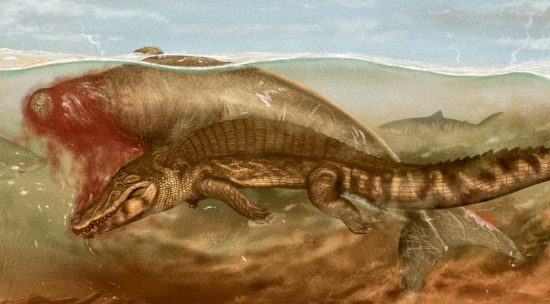In a groundbreaking discovery, paleontologists have unearthed the fossilized remains of a prehistoric sea cow in northern Venezuela, unveiling a dramatic tale of survival and predation from the Early to Middle Miocene epoch, roughly 23 to 11.6 million years ago. This remarkable find not only sheds light on the creature’s demise but also offers a rare glimpse into the intricate food webs of that era.
@MikeSirois @CashSports All the Sirois ancestors in the house.https://t.co/06y5rlTT9Y
“Prehistoric sea cow was eaten by a croc and a shark, newly discovered fossil reveals” pic.twitter.com/C5NQh73hjd— based acid ॐ (@B4s3d_4c1d) August 29, 2024
The fossil, identified as belonging to the genus Culebratherium, was found with distinct signs of attacks from not one, but two predators: an ancient crocodile and a tiger shark. This dual predation event marks a rare instance in paleontological records, providing insights into the predatory behaviors and ecological dynamics of the time.
Aldo Benites-Palomino, a researcher at the University of Zurich’s Department of Paleontology, expressed the significance of the discovery, noting that it’s uncommon to find evidence of multiple predators attacking a single prey. The skeleton, which included parts of the skull and 18 vertebrae, was remarkably preserved and provided clear evidence of the violent interactions it endured.
The attack likely commenced with the crocodile, which appears to have targeted the sea cow’s face, leaving deep tooth marks on its snout. This initial assault was probably an attempt to suffocate the prey. Subsequent marks suggest that the crocodile dragged and then performed a death roll—a tactic still used by modern crocodiles to subdue their prey.
Further examination revealed additional drama: a tiger shark tooth embedded in the sea cow’s neck and numerous slash marks across its skeleton. Known as opportunistic feeders, tiger sharks today often scavenge, suggesting similar behaviors existed millions of years ago.
The site of this remarkable find was first brought to attention by a local farmer who spotted unusual rock formations near Coro, prompting the team led by Marcelo Sanchez-Villagra, director of the Palaeontological Institute and Museum at Zurich, to investigate. After meticulous preparation, it took a team five people seven hours to extract the well-preserved skeleton from fine sediment—a testament to the site’s archaeological richness.
The detailed study of the bite marks—analyzing their shape, depth, and orientation—revealed the brutal nature of the attacks. The crocodile’s bites were characterized by semi-circular puncture wounds and wider curved gashes, while the shark’s were marked by long, narrow slits with V-shaped cross sections.
These findings not only underscore the violent nature of Miocene ecosystems but also draw parallels with modern food chains, where the remains of deceased animals continue to nourish other species. Benites-Palomino highlighted the rarity of such fossil records, which makes this discovery particularly significant for understanding both past and present ecological interactions.
Major Points:
- Paleontologists discovered fossilized remains of a prehistoric sea cow in northern Venezuela, showing signs of being attacked by both an ancient crocodile and a tiger shark during the Early to Middle Miocene epoch.
- This rare instance of one prey being targeted by two different predators provides unique insights into the Miocene era’s food chain dynamics.
- The sea cow’s skeleton exhibited deep tooth marks on its snout from the crocodile and slash marks across its body, indicative of a shark attack, along with a tiger shark tooth embedded in its neck.
- The fossil site was initially spotted by a local farmer and later excavated by a team from the University of Zurich, revealing the well-preserved skeleton after a careful seven-hour extraction process.
- The study of this fossil highlights similarities between ancient and modern food chains, where the remains of dead animals serve as food for multiple species, illustrating the continuity of ecological interactions through millions of years.
Conner T – Reprinted with permission of Whatfinger News

